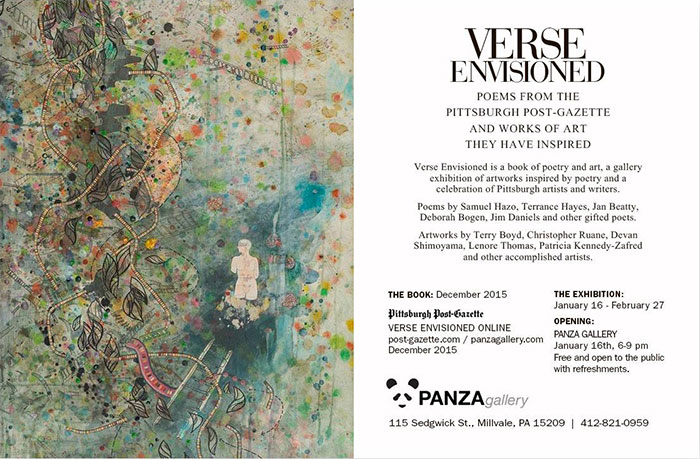01/09/2016
Verse Envisioned: Poems from the Post-Gazette and works of art they have inspired
A few months back I was asked by Curator Rachel Klipa in conjuction with the Pittsburgh Post Gazette to be a part of
Verse Envisioned. The project is a book and a gallery exhibition of poetry and art. It is a celebration of Pittsburgh’s vibrant artists and writers.
The poems were selected by a distinguished panel of poets from among more than 1,000 published in the Post-Gazette over the past 22 years. The original works of art were commissioned by curator Rachel Klipa. The results are:
• A book of 45 poems and 25 works of art, which will be available online by Jan. 15 at the PG Store.
• A poetry/art exhibition at the PANZA Gallery running Jan. 16 to Feb. 27. The public opening is from 6 to 9 p.m. Saturday, Jan. 16.
• An online multimedia presentation.


To explore the work in more detail please use the link provided and read the poem and artist statement below.
* http://www.christopherruane.com/Set/Stranger-Than-Life/TV-Dinner*
Yes, its very dark! When agreeing to be a part of this project I thought, this would be a chance to do something pleasant and less intense. The idea of creating a work of art inspired by a poem brought thoughts of flowers and love to mind. Fortunately however, I was chosen to work with a poem that would force me to engulf myself in the subject of the Vietnam War, the media, and the loss of our innocence and humanity. This was a grim and heavy task, but an experience I treasure because of what it taught me about our past and the echoes that are still heard in the hearts of so many. I found the similarities and progression of this horrific side of our nature to be evident in our everyday lives, right now in 2016. What we see, what we read, and what we plug into. We don't seem to have learned from these experiences or visual horrors. We have just created different and more readily available ways of viewing them. How close can we get before getting sucked in? The contradiction of our very purpose so evident. A lot can be summed up by the newspapers strewn across the floor in the work. Images of cartoons lay next to advertisements for assault rifles as the hand of God breathes life into Michaelangelo's Adam. Have we been living in an age where we are breathing in something completely different with our obsession with power, war and hatred? If you're not sure, no worries, just google it.
Here is the poem I was given and the accompanying artist statement:
REMEMBER THAT VIETNAMESE GUY THEY SHOT ON TV IN 1968?
by Chris Yeager
This is how I remember it
from the black and white TV: We were eating our dinner
when a Tall, White American soldier,
a Vietnamese man dressed like the American,
and another Vietnamese guy dressed
in a plaid shirt and black shorts
march to the front of the screen.
The American-looking Vietnamese turns his back to us
aims a gun at the head of the other Vietnamese, and
my old man bolts from his seat,
one fist shoved straight through the air
a butter knife clenched in the other,
gushes over spaghetti and bread and martini
''Attaboy Gook! That's how we do 'em!"
The second the shot
breaks into the brain
the body crumples
like paper, collapses
like a demolition
and I feel like it feels
when the ball carries over the lights
in the ninth, when the kick is up
and good!
like we've come from behind
with no time on the clock
that must be it, Oh Hell Yes
we're pulling for winners, the old man and me,
and he knows how it's done!
On screen a small pool of blood
circles like a comic-strip talk-balloon
above the head of the guy in the street.
The American soldier and the Vietnamese man
square up the TV with some sort of flag.
They fold it between them, a little triangle,
and the American takes it under his arm;
they march out of sight
as my mother clears the table.
Ruane photographed each image and composed the entire scene depicted in T .V. Dinner. His visually provocative work references iconic images associated with the Vietnam War. The man on fire symbolizes the indelible image of the burning monk, the woman pouring tea refers to the shooting described in Yeager’s poem, and the grotesque shadow looming in the background signifies the young Napalm Girl. For Ruane, Yeager’s poem highlighted the ugliness of war broadcast into the safety of U.S. homes. Watching murder on live television was now part of the dinner experience.




